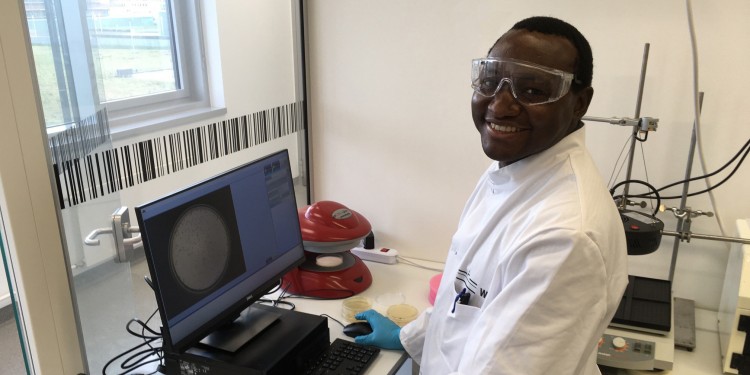
Innovative dyes for keeping produce fresh
In Sub-Saharan Africa, farmers rush their fresh fruits and vegetables to market to sell them before they go bad. It is so hot in this region that fruits and vegetables spoil three to four times faster than they do in Europe, making it impossible for farmers to fetch the full price for their hard work. Moreover, rotting fruits and vegetables can carry harmful bacteria and viruses that make people ill. To top it off, in most villages where fresh produce is grown, there is no electricity for refrigerating the produce to keep it fresher longer. As a result, 40 to 70 percent of fresh produce in Sub-Saharan Africa spoils before it can ever be used.
Dr. Hussaini Majiya wants to change this. He doesn’t want to do it with standard, expensive and extensive infrastructure, like refrigeration, but with innovative, elegant and ecologically friendly solutions.
Hussaini Majiya chose to become a scientist, he says, because “I love solving problems- especially local problems.” He recently finished his Ph.D. in Biomedical Sciences at the University of Leeds in the UK and now leads the Department of Microbiology at Ibrahim Badamasi Babangida University in Lapai, Nigeria.
Currently Hussaini Majiya is a guest scientist at the Center for Soft Nanoscience (SoN) at the University of Münster, where he is collaborating with Dr. Anzehla Galstyan, a junior research group leader. With financial support from the TWAS-DFG program, which enables German institutes to invite scientists from Sub-Saharan Africa for a three-month collaboration, they are investigating possible solutions for keeping produce fresh in Sub-Saharan Africa.
For their research, Hussaini Majiya brought material from two plants from Africa to test as photo-anti-microbial dyes, or solutions, for keeping produce fresher and safer longer: henna and hibiscus. He chose both plants carefully to make sure they are commonplace and have a long history of accepted safe use. These plants also have the benefit of not being staple foods, which Hussaini Majiya says he prefers not to “tamper with” in order to “prevent potential food security crises,” which can arise when staple foods are used for needs other than sustenance.
His collaboration with Anzehla Galstyan is producing exciting results. Dyes made from hibiscus and henna, which are activated by even very low levels of sunlight, effectively kill E.coli and Bacillus subtillis. These dyes can be mixed with water to wash and disinfect produce before it is sold in the market. Now that he has good results, Hussaini Majiya is excited to be expanding his research from bacteria to viruses using the viral model MS2-Phage, something made possible by Anzehla Galstyan’s experience and the excellent facilities at the SoN.
With only a few weeks left of his stay in Münster, Hussaini Majiya reflects on how pleased he is with his experience. Impressed by the atmosphere in the SoN, he likes that it has enough space to work and that it is “quiet enough for critical thinking,” and to top it off, the SoN is a “beautiful building” that inspires him when he is stressed with work.
As for the University of Münster: “They are great hosts. Münster has a culture of welcoming people. The university guest accommodation is good, which is important. And compared to Spain, more people are speaking English.” He definitely wants to come back and look for another program to continue collaborating, and he would be pleased to have Anzehla Galstyan come to his university in Nigeria as well.
International exchange is important, he says, because visiting scientists are able to bring their experience back to their own countries and transfer skills and influence the young generation. If he has one piece of advice to give people welcoming new colleagues from Sub-Saharan African, it is to greet them in the morning with a short chat. “In my culture it means a lot to us,” he says.
